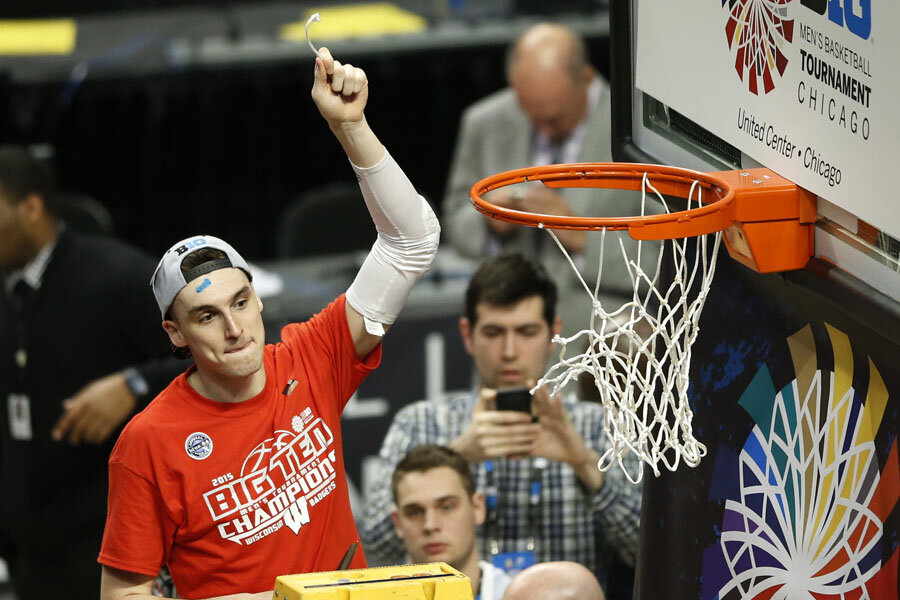Wisconsin
Did you know that head coach Bo Ryan previously led Div. III Wisconsin-Platteville to four NCAA championships, or that the student cheering section is known as the Grateful Red? Or that the Badgers were the 1941 NCAA champs?
Arizona
Did you know that Arizona was the first major-college program to hire an African-American head coach (Fred Snowden in 1972) or that the school has become known as “Point Guard U.” for its succession of great playmakers, including Steve Kerr, Mike Bibby, and Jason Terry?
Baylor
Did you know that the university created a memorial in 2007 on the 80th anniversary of the 1927 team bus crash with a train that killed 10 team members? Or that the coach of the “Immortal Ten,” Ralph Wolf, who survived, led the Bears to their first Southwest Conference championship in 1932? (The crash led to construction of train overpasses and other safety measures in Texas.)
North Carolina
Did you know that the Tar Heels, with their Four Corners stalling offense, are considered most responsible for the adoption of the college shot clock in 1985 or that late great coach Dean Smith, who made the Four Corners famous, has jokingly been called the only person able to keep Michael Jordan, who played for Smith, under 20 points a game?
Arkansas
Did you know that Nolan Richardson, who was fired for controversial remarks, led the Razorbacks to the 1994 NCAA championship, thus becoming the only coach with an NCAA Division I, NIT, and junior college championship?
Xavier
Did you know that one of the behind-the-scenes stars of the Xavier program is academic advisor Sister Rose Ann Fleming, who has for many years played a significant role in making sure the Musketeer players who complete their athletic eligibility graduate.
Virginia Commonwealth
Did you know that in 2011, the first year of play-in (“First Four”) games to the NCAA tournament, VCU advanced to the Final Four by upsetting top-seated Kansas in regional play? Or that coach Shaka Smart is named for a famous Zula warrior and is a magna cum laude history graduate of Kenyon College?
Oregon
Did you know that the Ducks won the first-ever NCAA championship, in 1939? The Tall Firs, as they were called, are honored today at Matthew Knight Arena with one of the most distinctive court designs in all of basketball, a playing surface fringed with silhouettes of fir trees.
Oklahoma State
Did you know that the OSU was the first school to win consecutive NCAA titles. As Oklahoma A&M, it won in 1945 and 1946 with Bob Kurland, the game’s first seven-footer, stationed in the pivot?
Ohio State
Did you know that Ohio State joins Villanova as the only other team that has played in the NCAA tournament every decade since it began in 1939?
Brigham Young
Did you know that BYU has the most NCAA appearances of any team that’s not made the Final Four or that it was the first US college program to suit up an international All-American player, Yugoslavia’s Kresimir Cosic, in 1972 and 1973?
Mississippi
Did you know the Ole Miss (20-12) managed to make the Big Dance despite losing four of its last five games, including a first-round loss to South Carolina in the Southeastern Conference tournament?
Wofford College
Did you know that despite enrolling only 1,600 students, this year marks the fourth basketball season since 2010 that the Spartanburg, S.C., school has made the NCAA tournament field?
Harvard
Did you know that Harvard beat Yale 53-51 in a one-game Ivy League playoff to win their fourth straight NCAA berth? The Crimson are coached by Tommy Amaker, a four-year starter for Duke in the 1980s.
Georgia State
Did you know that the Panthers head coach, Ron Hunter, sometimes coaches in his bare feet in a show of support for Samaritans Feet, a organization that donates footwear to poor children? Hunter was so excited after his team’s 38-36 win over Georgia Southern in the Sun Belt Conference championship game, that he injured his leg while joining his son, R.J., the team’s star player, in a celebratory hug.
Texas Southern
Did you know that the Tigers are led by coach Mike Davis, who took over for Bob Knight after Knight was fired by Indiana University in 2000?
Coastal Carolina
Did you know that Coastal Carolina’s unusual nickname, the Chanticleers, comes from Chaucer’s “Canterbury Tales”? It was selected for the rooster connection to the University of South Carolina Gamecocks before USC-Coastal Carolina College became Coastal Carolina University by splitting from the University of South Carolina system in 1993.







